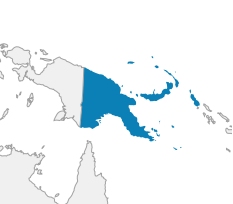Home / Fact sheets / Papua New Guinea / Population fact sheet
The World Bank (2023)
World Health Organization (2021)
UNDP Human Development Report (2022)
World Health Organization (2019)
GLOBOCAN (2022)
Check also the following factsheets: Breast, Cervical, Colorectal
Country fact sheet: Papua New Guinea
| - Total population: | 10 329 931 |
| - Female population: | 5 006 583 |
| - Male population: | 5 323 347 |
Health Expenditure
| - Total per capita (US$): | 61.4 |
| - Out-of-pocket (% of total expenditure on health): | 10.4 |
| - UHC Service Coverage Index: | 30 |
Human Development Index
| - HDI: | 0.568 |
| - Category: | Medium |
Geography
 |
Life Expectancy at Birth
| - Total population (years): | 65.3 |
| - Female population (years): | 67.4 |
| - Male population (years): | 63.4 |
Cancer Burden
| - Overall cancer incidence (rate per 100 000 persons per year): | 188.7 |
| - Overall cancer mortality (rate per 100 000 persons per year): | 119.8 |
| - Most common cancer site by incidence for females (rate per 100 000 persons per year): | Breast (46.0) |
| - Most common cancer site by mortality for females (rate per 100 000 persons per year): | Breast (26.7) |
| - Most common cancer site by incidence for males (rate per 100 000 persons per year): | Prostate (28.3) |
| - Most common cancer site by mortality for males (rate per 100 000 persons per year): | Lung (15.9) |
| - GLOBOCAN 2020 population fact sheet |
Check also the following factsheets: Breast, Cervical, Colorectal

